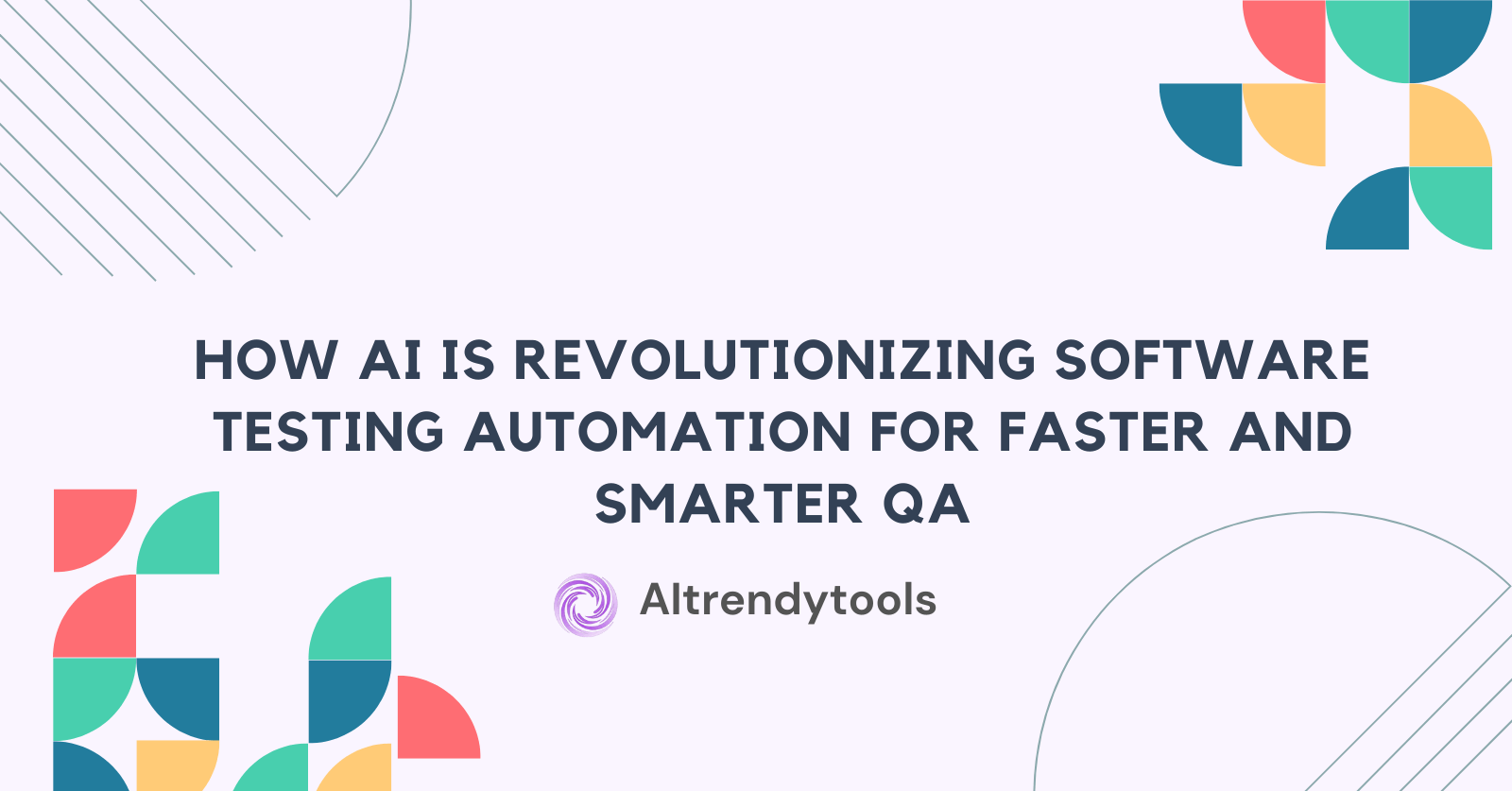🔥 AITrendytools: The Fastest-Growing AI Platform |
Write for usHow AI is Revolutionizing Software Testing Automation for Faster and Smarter QA
Discover how AI-driven software testing automation is transforming QA processes, improving efficiency, and reducing manual effort for seamless software development.
Jul 29, 2025
Introduction
In today’s fast-paced and competitive software development landscape, ensuring the reliability, efficiency, and overall quality of applications has become more critical than ever. Organizations are under constant pressure to release software quickly while maintaining high standards to meet user expectations and business goals. This challenge falls heavily on Quality Assurance (QA) teams, who must balance speed and accuracy in testing processes. However, traditional software testing methods often struggle to keep up with the rapid pace of development, particularly in agile and DevOps environments. Manual testing and conventional automated approaches can be time-consuming, resource-intensive, and prone to human error, leading to bottlenecks that hinder productivity and delay releases.
This is where Artificial Intelligence (AI) in software testing automation is making a transformative impact. AI-driven testing solutions are redefining how software is tested by leveraging machine learning, predictive analytics, and intelligent automation to enhance accuracy, efficiency, and overall software quality. These advanced technologies can analyze vast amounts of test data, identify patterns, predict defects, and adapt to evolving testing requirements—significantly reducing the effort required for test case creation, execution, and maintenance.
By integrating AI into testing automation, companies can not only accelerate the testing process but also improve defect detection rates, optimize test coverage, and ensure seamless user experiences. In this article, we’ll explore how AI is revolutionizing testing automation, the key benefits it brings to QA teams, and why AI-driven tools are shaping the future of software quality assurance.
The Need for AI in Software Testing
Software testing is a fundamental phase in the software development lifecycle (SDLC) that ensures applications function correctly, securely, and efficiently. However, traditional testing methodologies face several challenges that hinder the speed and effectiveness of the development process. As software complexity grows and rapid releases become the norm, the limitations of manual and conventional automated testing approaches become more apparent. Partnering with providers of software development services can help integrate advanced testing tools and practices to overcome these challenges effectively. These challenges include:
- Time-consuming manual testing: Manual testing involves executing repetitive test cases, which slows down the development cycle. As applications evolve, the need to run regression tests on multiple versions further extends testing timelines, leading to delays in software releases.
- High maintenance in automated testing: Traditional automated testing relies on script-based frameworks, which require constant updates whenever there are changes in the application’s UI, functionality, or workflows. Maintaining test scripts for frequently changing software can be resource-intensive and costly.
- Limited test coverage: Traditional testing methods may not cover all possible scenarios, including rare edge cases that could lead to system failures. Due to time and resource constraints, QA teams often focus on predefined test cases, leaving gaps that increase the risk of undetected defects.
- Human error and inconsistency: Manual testing is prone to oversight, misinterpretation, and inconsistencies between different testers. The accuracy of test execution and reporting may vary depending on individual expertise and fatigue, leading to unreliable results.
To overcome these challenges, AI-driven software testing automation is revolutionizing the industry by introducing machine learning (ML) algorithms, natural language processing (NLP), and predictive analytics into the testing process. AI-powered tools can:
- Optimize test execution speed by identifying high-risk areas and prioritizing test cases accordingly.
- Enhance test maintenance with self-healing test scripts that automatically adapt to changes in the application.
- Improve test coverage by intelligently generating test scenarios, including edge cases that are difficult to anticipate manually.
- Minimize human intervention by autonomously detecting defects, analyzing patterns, and providing actionable insights to developers and QA teams.
By leveraging AI, organizations can streamline their testing efforts, reduce costs, and significantly improve software quality, making AI-driven testing automation a necessity rather than a luxury in today’s fast-moving software landscape.
How AI is Transforming Software Testing Automation
AI-driven test automation is revolutionizing software testing by going beyond simple script execution—it optimizes the entire testing lifecycle. By leveraging machine learning, predictive analytics, and intelligent automation, AI enhances efficiency, accuracy, and scalability in testing processes. For organizations seeking to maximize these benefits, working with dedicated software engineers who specialize in AI testing frameworks ensures proper implementation and ongoing optimization of intelligent automation systems. Let’s explore the key ways AI is transforming software testing automation.
1. AI-Powered Test Case Generation
Traditionally, QA teams spend significant time manually creating test cases based on application requirements and user workflows. However, AI can automatically generate test cases by analyzing:
- Application requirements and design documents to extract functional test scenarios.
- User behavior and interaction patterns to identify real-world usage scenarios.
- Historical test data to refine test cases and eliminate redundancies.
AI-driven test case generation ensures comprehensive test coverage while reducing manual effort. It also dynamically updates test cases as software evolves, helping teams keep pace with rapid development cycles.
2. Self-Healing Test Automation
One of the most persistent challenges in traditional automated testing is the maintenance of test scripts when UI changes occur. Even minor UI modifications—such as a button repositioning or a label change—can cause scripted tests to fail. AI-driven self-healing automation solves this issue by:
- Detecting UI changes using computer vision and NLP and automatically adjusting test scripts.
- Minimizing script maintenance efforts by updating locators and element identifiers dynamically.
- Ensuring higher test execution success rates with reduced manual intervention.
Advanced computer vision applications originally developed for medical imaging and facial recognition have been adapted to make UI element detection significantly more accurate and reliable in testing environments.
3. Intelligent Bug Detection and Root Cause Analysis
AI doesn’t just identify bugs—it predicts and prevents them. By leveraging machine learning, AI can:
- Analyze past test results and production data to detect patterns that lead to failures.
- Flag code changes that have historically introduced defects to warn developers early.
- Pinpoint the root cause of failures by correlating test logs, error messages, and system behavior.
This predictive approach enables proactive bug resolution, reducing the number of defects that make it into production.
4. AI-Driven Regression Testing
Regression testing ensures that new code changes do not break existing functionalities. However, running a full suite of regression tests can be time-consuming. AI enhances this process by:
- Prioritizing the most critical test cases based on risk assessment.
- Identifying redundant and low-value tests to optimize execution time.
- Improving test coverage by generating targeted test scenarios that address edge cases.
By optimizing regression testing, AI accelerates development cycles while maintaining software stability.
5. Faster Test Execution with AI-Driven Parallel Testing
Testing large applications often involves executing thousands of test cases across multiple environments, which can be time-consuming. AI-powered parallel testing optimizes execution by:
- Distributing test cases across cloud-based or on-premise test environments for concurrent execution.
- Utilizing intelligent resource allocation to run tests efficiently.
- Reducing testing time from hours to minutes, enabling faster software releases.
Parallel execution ensures that teams can meet tight release deadlines without compromising quality.
6. Enhanced Test Data Generation and Management
Reliable test data is crucial for accurate test execution, but manually creating diverse and realistic datasets is challenging. AI simplifies test data generation by:
- Analyzing production data patterns to create synthetic but realistic test datasets.
- Masking sensitive information for compliance with data privacy regulations.
- Generating edge-case scenarios to test how software handles unexpected inputs.
AI-driven test data management improves test accuracy and ensures software robustness in real-world conditions.
7. AI-Powered Visual Testing
Ensuring a consistent user experience across various devices, browsers, and screen sizes is critical. Traditional visual testing methods rely on manual reviews, which can be error-prone. AI-powered visual testing automates this process by:
- Using image recognition and computer vision to detect UI inconsistencies.
- Comparing visual elements pixel by pixel across different resolutions and devices.
- Identifying unintended UI changes such as misaligned elements, incorrect fonts, or color discrepancies.
AI-driven visual testing ensures a seamless and visually consistent user experience across multiple platforms.
Key Benefits of AI in Software Testing
The integration of AI into software testing automation brings transformative advantages for QA teams and businesses alike. By leveraging machine learning, predictive analytics, and intelligent automation, AI-driven testing enhances efficiency, accuracy, and scalability. Below are the key benefits of AI in software testing:
Reduced Testing Time
One of the most significant advantages of AI-driven testing is the ability to accelerate testing cycles by automating repetitive and time-consuming tasks. Traditional manual and script-based testing methods often require substantial time investments, slowing down the development process. AI optimizes test execution in several ways:
- Automated test case generation reduces the need for manual scripting.
- Intelligent test prioritization ensures critical tests run first.
- Parallel execution capabilities allow multiple tests to run simultaneously across different environments.
By reducing testing time, AI enables faster product releases, allowing businesses to meet tight deadlines while maintaining high software quality.
Increased Accuracy
Manual testing is prone to human errors, including oversight, inconsistencies, and misinterpretation of test results. AI-powered testing eliminates these risks by ensuring precise and consistent test execution every time. AI-driven tools can:
- Detect UI changes and automatically update test scripts (self-healing automation).
- Identify anomalies in application behavior using machine learning-based anomaly detection.
- Provide real-time insights into test results, reducing the chances of undetected defects.
By eliminating human error, AI enhances software reliability and reduces the likelihood of production failures.
Cost Efficiency
AI-powered test automation helps organizations reduce operational costs in several ways:
- Minimizing manual testing efforts, reducing the need for large QA teams.
- Lowering maintenance costs by automatically adapting to software changes.
- Reducing defect-related expenses by detecting issues earlier in the development cycle, preventing costly bug fixes later.
By improving testing efficiency and accuracy, AI-driven testing enables businesses to allocate resources more effectively, resulting in lower overall testing costs.
Improved Test Coverage
AI dramatically enhances test coverage by leveraging big data analytics, historical test results, and user behavior insights to identify critical test scenarios that may be overlooked in traditional testing. AI-driven tools can:
- Analyze vast amounts of data to identify potential edge cases.
- Automatically generate and execute test cases for different user environments, devices, and network conditions.
- Continuously expand test coverage by learning from past defects and adapting test scenarios accordingly.
By ensuring more comprehensive testing, AI helps catch defects that might otherwise slip through manual and conventional automated testing methods.
Continuous Testing in DevOps & Agile
Modern software development methodologies such as Agile and DevOps demand continuous testing and rapid feedback loops. AI-powered testing seamlessly integrates into these workflows by:
- Automating continuous testing across multiple stages of the development pipeline.
- Providing real-time defect detection and root cause analysis, enabling faster resolution.
- Optimizing test execution based on code changes, reducing unnecessary re-testing.
Companies that integrate devops services into their workflow can further enhance this continuous testing approach and achieve even greater efficiencyTop AI-Powered Tools for Software Testing Automation
Several AI-driven test automation tools are leading the industry with their innovative capabilities. These include:
- TestRigor – A no-code AI-powered tool that simplifies software testing automation, making test creation and maintenance easier.
- Applitools – Specializes in AI-based visual testing.
- Mabl – Uses machine learning to enhance end-to-end testing.
- Functionize – Automates test case creation with AI-driven insights.
For more insights into the latest testing tools, check out this blog for QA professionals that covers industry trends and automation best practices.
Challenges in AI-Powered Testing and How to Overcome Them
Despite its benefits, AI-driven test automation comes with some challenges:
🔹 Initial Implementation Costs – AI-based solutions may require an initial investment, but the long-term ROI outweighs the costs.
🔹 Learning Curve – QA teams must adapt to new AI-powered tools, requiring training and upskilling.
🔹 Data Dependency – AI models rely on large datasets, so organizations must ensure high-quality data for accurate test predictions.
To overcome these challenges, businesses should start with AI-assisted tools like TestRigor, which offer a user-friendly approach to automated testing.
The Future of AI in Software Testing
AI is not just a trend—it’s the future of software testing. As AI continues to evolve, we can expect:
- More advanced self-healing automation that eliminates script maintenance.
- AI-powered voice and chatbot testing to validate conversational AI applications.
- Predictive test automation that identifies issues before they impact users.
- Greater integration with DevSecOps to enhance security testing.
As businesses embrace AI-driven software testing automation, they will achieve higher efficiency, reduced costs, and faster time-to-market for their software products.
Final Thoughts
The integration of AI in software testing is transforming the way QA teams approach automation. From intelligent test case generation to predictive defect analysis, AI-powered tools like TestRigor are enabling organizations to achieve more efficient, scalable, and reliable testing.
For businesses looking to stay ahead in the competitive software landscape, embracing AI-driven test automation is no longer an option—it’s a necessity.
Are you ready to explore the future of software testing automation? Start leveraging AI-powered testing tools today and take your QA strategy to the next level.
🚀 Submit Your Tool to Our Comprehensive AI Tools Directory
Get your AI tool featured on our complete directory at AITrendytools and reach thousands of potential users. Select the plan that best fits your needs.





Join 30,000+ Co-Founders
Related Blogs
How AI May Change the Future of Online Casinos
Discover how AI is transforming online casinos with personalized gameplay, enhanced security, smarter marketing, and improved player protection.
Cash-Reward Gaming: Market Mechanics Meet Real-Time Play
Explore how cash-reward gaming merges market mechanics with real-time play, balancing payouts, risk, and engagement in a data-driven ecosystem.
The Next Wave of Fintech Tools: Smarter Spend Management Solutions
Discover the next wave of fintech spend management tools—real-time tracking, AI insights, and smarter controls for faster, clearer financial decisions.
Submit Your Tool to Our Comprehensive AI Tools Directory
List your AI tool on AItrendytools and reach a growing audience of AI users and founders. Boost visibility and showcase your innovation in a curated directory of 30,000+ AI apps.





Join 30,000+ Co-Founders

